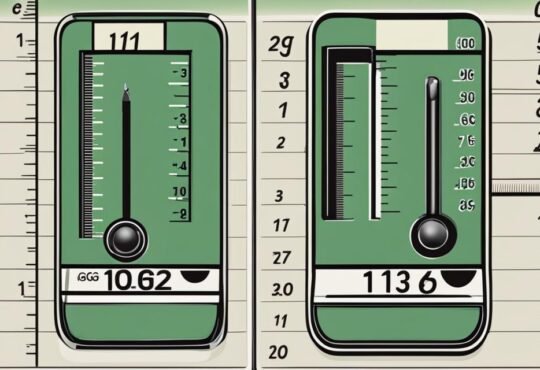
Convert 83g to kg – Quick & Easy Weight Conversion
Welcome to our guide on converting grams to kilograms! If you’re wondering how to convert 83 grams to kilograms, you’ve come to the right place. Whether you’re studying physics, working in a laboratory, or simply curious about weight conversions, we’ll explain the process in a quick and easy way.
Grams and kilograms are units of weight commonly used in various fields. To convert 83 grams to kilograms, all you need to do is multiply the amount in grams by the conversion factor of 0.001. This will give you the equivalent weight in kilograms. In this case, the conversion would look like this:
83 grams * 0.001 = 0.083 kilograms
Contents
- 1 Understanding Mass and Weight
- 2 Units of Mass
- 3 Conclusion
- 4 FAQ
- 4.1 What does it mean to convert 83g to kg?
- 4.2 How do I convert 83 grams to kilograms?
- 4.3 What is the difference between mass and weight?
- 4.4 What are the different units of mass?
- 4.5 Why is understanding mass and weight important?
- 4.6 Can mass affect space and time?
- 4.7 Why is the kilogram the SI unit of mass?
- 4.8 What are the steps to convert grams to kilograms?
Key Takeaways:
- Converting grams to kilograms is a simple process: Multiply the amount in grams by 0.001
- 83 grams is equal to 0.083 kilograms
- Grams and kilograms are common units of weight used in various fields
- The conversion factor between grams and kilograms is 0.001
- Understanding weight conversions can be useful in physics, laboratories, and everyday life
Understanding Mass and Weight
In everyday use, the terms “mass” and “weight” are often used interchangeably, but in physics, they have different meanings.
Mass is an inherent property of an object that represents its resistance to acceleration. It is a fundamental characteristic of matter. For example, an elephant has a greater mass than a mouse, so it requires more force to accelerate the elephant compared to the mouse. The unit of mass is the kilogram (kg).
Weight, on the other hand, refers to the force that an object experiences due to gravity. It is calculated as the product of an object’s mass and the acceleration due to gravity. Weight can vary depending on the location in the universe. For instance, an object would weigh less on the moon compared to Earth due to the moon’s lower gravitational acceleration.
Gravitational mass is a measure of the gravitational force experienced by an object. It determines how strongly an object is attracted to other objects with mass. In other words, it quantifies the gravitational pull an object exerts or experiences.
Inertial mass is a property of an object that resists changes in its motion. It determines how easily an object can be accelerated. In essence, it quantifies an object’s resistance to changes in motion.
Interestingly, according to the theory of relativity, mass can also affect the curvature of space-time. This leads to fascinating phenomena such as gravitational lensing, where light is bent by massive objects, and time dilation, where time appears to pass slower in strong gravitational fields.
Understanding the difference between mass and weight is crucial for comprehending various physical phenomena and scientific theories. It enables scientists to accurately describe and predict the behavior of objects in different gravitational environments.
Units of Mass
In the world of measurement, mass is an important concept to understand. Different units are used to quantify mass in various fields, from scientific research to everyday life. Let’s explore some of the common units of mass.
Kilogram
The kilogram (kg) is the standard unit of mass in the International System of Units (SI). It is defined as the weight of a specific platinum-iridium cylinder stored at the International Bureau of Weights and Measures in France. The kilogram is widely used for measuring everyday objects as well as in scientific calculations.
Electronvolt
In the field of particle physics, energy and mass are often interchangeable. The electronvolt (eV) is a unit of energy that is commonly used to express mass in this context. The electronvolt is defined as the amount of energy gained by an electron when it is accelerated through an electric potential difference of one volt.
Atomic Mass Unit
The atomic mass unit (amu) is a unit of mass commonly used in chemistry and physics. It is defined as one-twelfth the mass of a carbon-12 atom. The atomic mass unit is useful for expressing the masses of atoms and molecules, allowing scientists to compare the relative weights of different elements and compounds.
Slug
The slug is a unit of mass used in the United States customary system. It is primarily used in engineering and physics, particularly in relation to force and acceleration calculations. One slug is equal to approximately 32.174 pounds or about 14.5939 kilograms.
Solar Mass
In the field of astronomy, a unit called the solar mass is used to measure the mass of celestial objects, such as stars and planets. It represents the mass of our Sun, which is approximately 1.989 × 10^30 kilograms. The solar mass provides a useful benchmark for comparing the masses of other celestial bodies in the universe.
Carat
The carat (ct) is a unit of mass primarily used in the jewelry industry to measure the weight of gemstones, such as diamonds and pearls. One carat is equal to 200 milligrams or 0.2 grams. The carat weight of a gemstone is often used to determine its value and rarity.
Grain
The grain is a unit of mass that has a historical significance and is still used in certain industries today. It is commonly used in the measurement of gunpowder, bullets, and arrowheads. One grain is equal to approximately 64.79891 milligrams or 0.0648 grams.
Understanding these units of mass allows for precise measurements and calculations in various fields, including physics, chemistry, astronomy, and jewelry-making.
Comparison of Units of Mass
| Unit | Equivalent |
|---|---|
| Kilogram (kg) | 1 kilogram (kg) = 1,000 grams (g) |
| Electronvolt (eV) | 1 electronvolt (eV) = 1.602 × 10^-19 joules (J) |
| Atomic Mass Unit (amu) | 1 atomic mass unit (amu) = 1.66 × 10^-27 kilograms (kg) |
| Slug | 1 slug ≈ 14.5939 kilograms (kg) |
| Solar Mass | 1 solar mass = 1.989 × 10^30 kilograms (kg) |
| Carat (ct) | 1 carat (ct) = 0.2 grams (g) |
| Grain | 1 grain ≈ 0.0648 grams (g) |
Conclusion
Converting grams to kilograms is a straightforward process that can be done by multiplying the amount in grams by the conversion factor of 0.001. This conversion is essential in various fields, including physics, astronomy, and jewelry-making, where accurate weight measurements are crucial.
Understanding the concepts of mass and weight is equally important. While mass represents an object’s resistance to acceleration, weight refers to the force acting on an object due to gravity. By grasping these distinctions, you can navigate weight and mass measurements more effectively in your daily life.
Familiarizing yourself with different units of mass is also beneficial. The kilogram, an SI unit of mass, is widely used, while other units such as the electronvolt, atomic mass unit, slug, solar mass, carat, and grain have their specific applications. Developing a comprehensive knowledge of these units will enhance your understanding of weight and mass in different contexts.
Whether you are calculating grams to kilograms or exploring the intricate world of mass units, mastering these conversions and units provides invaluable insights into the fundamental principles of weight and mass. With this knowledge, you can confidently tackle weight conversions and make accurate mass measurements in various fields of study and interest.
FAQ
What does it mean to convert 83g to kg?
Converting 83 grams to kilograms means converting a mass measurement from a smaller unit (grams) to a larger unit (kilograms). It allows for easier comparison and understanding of weight in different units.
How do I convert 83 grams to kilograms?
To convert 83 grams to kilograms, you can use a simple conversion factor. Multiply the amount in grams (83) by 0.001, which is the conversion factor for grams to kilograms. The result will be 0.083 kilograms.
What is the difference between mass and weight?
Mass is a measure of the resistance of an object to acceleration, while weight refers to the force that acts on an object due to gravity. Mass is an inherent property of an object, whereas weight depends on the gravitational force. In physics, weight is calculated as the product of mass and gravitational acceleration.
What are the different units of mass?
There are several units of mass used in different fields. The kilogram (kg) is the SI unit of mass and is widely used. Other units include the electronvolt (eV), atomic mass unit (amu), slug, solar mass, carat, and grain. These units are used in various contexts such as particle physics, astronomy, and jewelry-making.
Why is understanding mass and weight important?
Understanding the concepts of mass and weight is important in various fields of science and everyday life. It helps in physics calculations, allows for accurate weight comparisons, and enables proper measurement and estimation in industries such as manufacturing, jewelry-making, and engineering.
Can mass affect space and time?
Yes, according to the theory of relativity, mass can affect the curvature of space-time. This can lead to phenomena like gravitational lensing and time dilation. Massive objects have the ability to bend the fabric of space and time, influencing the paths of other objects and the perception of time in their vicinity.
Why is the kilogram the SI unit of mass?
The kilogram is the SI unit of mass because it is a well-defined unit that is easily reproducible. It is currently defined as the weight of a specific platinum-iridium cylinder kept in a controlled environment. The kilogram provides a standardized unit for mass measurements across the globe.
What are the steps to convert grams to kilograms?
To convert grams to kilograms, you can follow a straightforward process. Multiply the amount in grams by the conversion factor of 0.001. The result will be the equivalent value in kilograms. For example, to convert 83 grams to kilograms, you would multiply 83 by 0.001, yielding 0.083 kilograms.
Convert Your Units here: https://nosygeek.com/calculator-converter-g-to-kg







